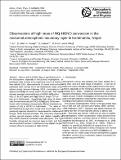| dc.contributor.author | Yu, Y. | |
| dc.contributor.author | Galle, B. | |
| dc.contributor.author | Panday, Arnico K. | |
| dc.contributor.author | Hodson, Elke Lynn | |
| dc.contributor.author | Prinn, Ronald G | |
| dc.date.accessioned | 2011-08-25T16:31:36Z | |
| dc.date.available | 2011-08-25T16:31:36Z | |
| dc.date.issued | 2009-09 | |
| dc.date.submitted | 2009-07 | |
| dc.identifier.issn | 1680-7324 | |
| dc.identifier.issn | 1680-7316 | |
| dc.identifier.uri | http://hdl.handle.net/1721.1/65358 | |
| dc.description.abstract | Nitrous acid (HONO) plays a significant role in
the atmosphere, especially in the polluted troposphere. Its
photolysis after sunrise is an important source of hydroxyl
free radicals (OH). Measurements of nitrous acid and other
pollutants were carried out in the Kathmandu urban atmosphere
during January–February 2003, contributing to the
sparse knowledge of nitrous acid in South Asia. The results
showed average nocturnal levels of HONO (1.7±0.8 ppbv),
NO2 [NO subscript 2] (17.9±10.2 ppbv), and PM10(0.18±0.11 mgm−3 [mg m superscript -3]) in urban
air in Kathmandu. Surprisingly high ratios of chemically
formed secondary [HONO] to [NO2] [NO subscript 2] (up to 30%) were
found, which indicates unexpectedly efficient chemical conversion
of NO2 [NO subscript 2] to HONO in Kathmandu. The ratios of
[HONO]/[NO2] [NO subscript 2] at night were found to be much higher than
previously reported values from measurements in urban air in
Europe, North America and Asia. The influences of aerosol
surface, ground reactive surface, and relative humidity on
NO2-HONO [NO subscript 2 - HONO] chemical conversion were discussed. The high
humidity, strong and low inversion layer at night, and high
aerosol pollution burden in Kathmandu may explain the particularly
efficient conversion of NO2 [NO subscript 2] to HONO. | en_US |
| dc.description.sponsorship | Alliance for Global Sustainability | en_US |
| dc.description.sponsorship | Massachusetts Institute of Technology. Joint Program on the Science & Policy of Global Change | en_US |
| dc.language.iso | en_US | |
| dc.publisher | European Geosciences Union / Copernicus | en_US |
| dc.relation.isversionof | http://dx.doi.org/10.5194/acp-9-6401-2009 | en_US |
| dc.rights | Creative Commons Attribution 3.0 | en_US |
| dc.rights.uri | http://creativecommons.org/licenses/by/3.0 | en_US |
| dc.source | Copernicus | en_US |
| dc.title | Observations of high rates of NO2-HONO [NO subscript 2 - HONO] conversion in the nocturnal atmospheric boundary layer in Kathmandu, Nepal | en_US |
| dc.type | Article | en_US |
| dc.identifier.citation | Yu, Y. et al. “Observations of High Rates of NO2 [NO subscript 2]-HONO Conversion in the Nocturnal Atmospheric Boundary Layer in Kathmandu, Nepal.” Atmospheric Chemistry and Physics 9.17 (2009) : 6401-6415. © Author(s) 2009 | en_US |
| dc.contributor.department | Massachusetts Institute of Technology. Center for Global Change Science | en_US |
| dc.contributor.department | Massachusetts Institute of Technology. Department of Earth, Atmospheric, and Planetary Sciences | en_US |
| dc.contributor.approver | Prinn, Ronald G. | |
| dc.contributor.mitauthor | Panday, Arnico K. | |
| dc.contributor.mitauthor | Hodson, Elke Lynn | |
| dc.contributor.mitauthor | Prinn, Ronald G. | |
| dc.relation.journal | Atmospheric Chemistry and Physics | en_US |
| dc.eprint.version | Final published version | en_US |
| dc.type.uri | http://purl.org/eprint/type/JournalArticle | en_US |
| eprint.status | http://purl.org/eprint/status/PeerReviewed | en_US |
| dspace.orderedauthors | Yu, Y.; Galle, B.; Panday, A.; Hodson, E.; Prinn, R.; Wang, S. | en |
| dc.identifier.orcid | https://orcid.org/0000-0001-8616-3369 | |
| dc.identifier.orcid | https://orcid.org/0000-0001-5925-3801 | |
| mit.license | PUBLISHER_CC | en_US |
| mit.metadata.status | Complete | |
